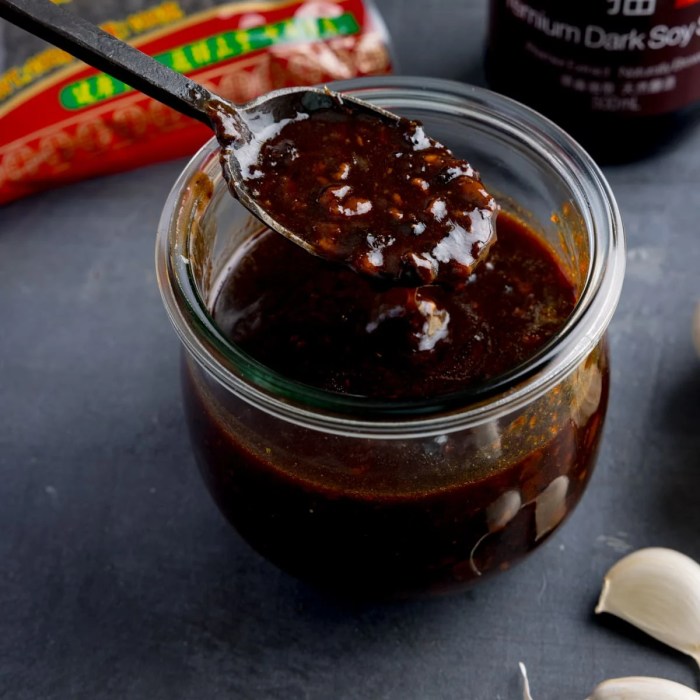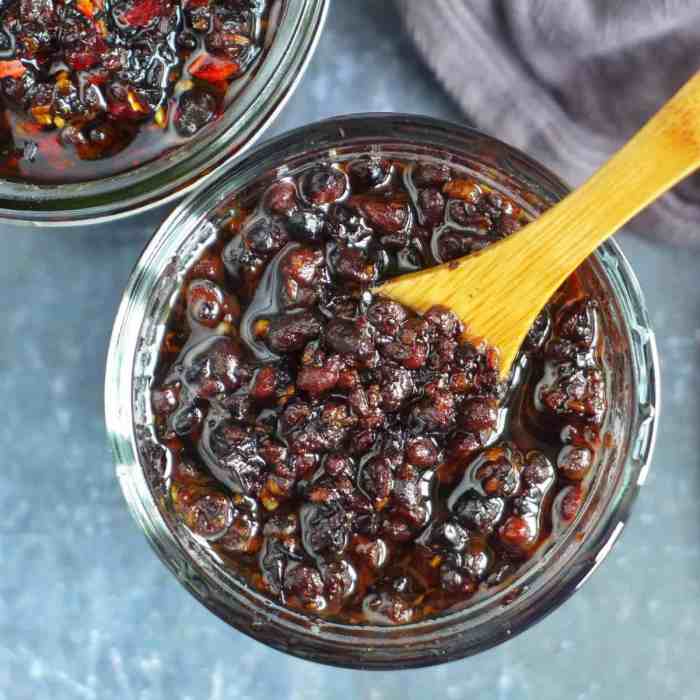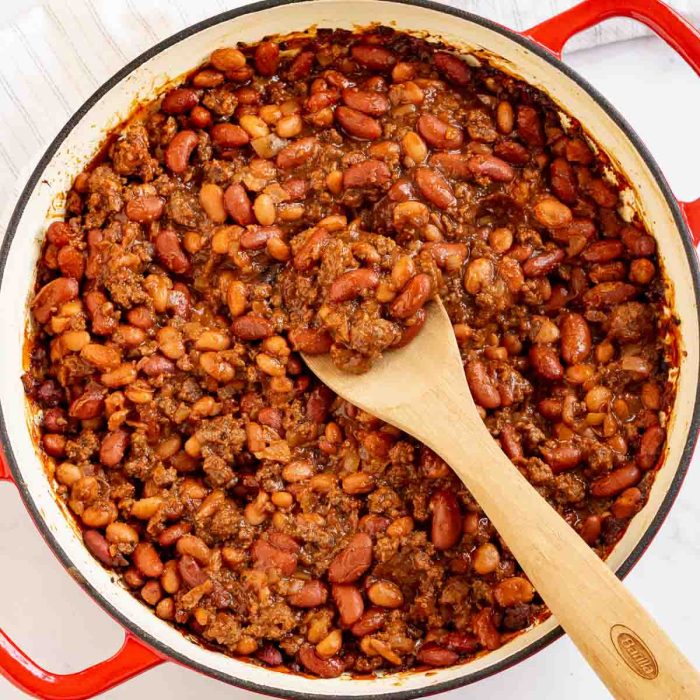Baked Bean Sauce Recipe A Culinary Guide
Baked Bean Sauce: A Culinary Exploration
Baked bean sauce recipe – Baked bean sauce, a versatile and flavorful condiment, offers a world of culinary possibilities. From its humble beginnings as a simple side dish, it has evolved into a key ingredient in numerous recipes, showcasing its adaptability and deliciousness. This exploration delves into the various aspects of baked bean sauce, covering recipe variations, ingredient exploration, cooking methods, serving suggestions, and nutritional information.
Baked Bean Sauce Recipe Variations

Source: kitchensanctuary.com
Three distinct recipes illustrate the versatility of baked bean sauce: a classic, a spicy, and a vegetarian option. Each recipe showcases unique flavor profiles achieved through careful ingredient selection and preparation techniques.
| Ingredient | Quantity | Instructions | Notes |
|---|---|---|---|
| Classic Baked Beans | |||
| Kidney beans (canned) | 2 (15-ounce) cans | Drain and rinse beans. | Use other beans like navy or pinto for similar results. |
| Chopped onion | 1 medium | Sauté until softened. | Adds sweetness and depth of flavor. |
| Tomato paste | 2 tablespoons | Cook with onions for a richer flavor. | Adds body and acidity. |
| Brown sugar | 2 tablespoons | Stir in with other ingredients. | Balances acidity and adds sweetness. |
| Molasses | 1 tablespoon | Adds depth of flavor and richness. | Optional, but recommended. |
| Worcestershire sauce | 1 tablespoon | Adds umami and savory notes. | Use a vegetarian alternative if needed. |
| Mustard (dry or Dijon) | 1 teaspoon | Adds tanginess and complexity. | Experiment with different types of mustard. |
| Salt and pepper | To taste | Season to preference. | Adjust to your liking. |
| Spicy Baked Beans | |||
| Kidney beans (canned) | 2 (15-ounce) cans | Drain and rinse beans. | Use other beans like black beans for a different texture. |
| Chopped onion | 1 medium | Sauté until softened. | Adds sweetness and depth of flavor. |
| Jalapeño peppers (finely chopped) | 2 | Add with onions for a spicy kick. | Remove seeds for less heat. |
| Chipotle peppers in adobo sauce | 1-2 (depending on desired heat) | Adds smoky heat and depth. | Use less for milder heat. |
| Tomato sauce | 1 (28-ounce) can | Provides the base for the sauce. | Use fire-roasted tomatoes for a smokier flavor. |
| Cumin | 1 teaspoon | Adds warm earthiness. | Pairs well with the chipotle peppers. |
| Salt and pepper | To taste | Season to preference. | Adjust to your liking. |
| Vegetarian Baked Beans | |||
| Cannellini beans (canned) | 2 (15-ounce) cans | Drain and rinse beans. | Other white beans can be substituted. |
| Diced carrots | 1 cup | Adds sweetness and texture. | Other vegetables like celery or bell peppers can be added. |
| Chopped celery | 1 stalk | Adds a fresh, slightly bitter note. | Optional, but adds complexity. |
| Vegetable broth | 1 cup | Provides liquid for the sauce. | Use low-sodium broth. |
| Tomato purée | 1/2 cup | Adds thickness and acidity. | Use sun-dried tomatoes for a more intense flavor. |
| Soy sauce | 2 tablespoons | Adds umami and saltiness. | Use tamari for gluten-free option. |
| Maple syrup | 1 tablespoon | Adds sweetness and balances acidity. | Agave nectar can be substituted. |
| Dried oregano | 1 teaspoon | Adds an earthy, herbaceous note. | Other herbs like thyme or rosemary can be used. |
| Salt and pepper | To taste | Season to preference. | Adjust to your liking. |
The classic recipe relies on a balance of sweet and savory flavors, achieved through the combination of brown sugar, molasses, and Worcestershire sauce. The spicy version incorporates jalapeños and chipotle peppers for a fiery kick, complemented by cumin for warmth. The vegetarian recipe utilizes vegetable broth and soy sauce to create umami depth, while maple syrup balances the acidity of the tomato purée.
Cooking methods vary slightly across the recipes. While simmering on the stovetop is common, slow cooking offers a more tender bean texture. The stovetop method allows for more immediate adjustments to seasoning and consistency.
Key Ingredient Roles and Substitutions

Source: redhousespice.com
Beans provide the foundation, offering both texture and nutritional value. Tomatoes add acidity and sweetness, while onions contribute depth and complexity. Spices such as cumin, oregano, and chipotle peppers add layers of flavor. Substitutions are possible; for instance, black beans can replace kidney beans, while different types of peppers offer varying degrees of heat.
To maximize umami, consider adding ingredients like mushrooms, soy sauce (or tamari), and nutritional yeast to a baked bean recipe. These ingredients naturally contain glutamates, which enhance the savory flavor profile.
Cooking Methods: Slow Cooker vs. Stovetop
Slow cookers provide a hands-off approach, resulting in incredibly tender beans. However, they may require longer cooking times. The stovetop method offers more control over the cooking process, allowing for adjustments in consistency and seasoning. Simmering is crucial to achieve a well-balanced flavor and tender beans.
Slow cooking generally results in a softer, more uniformly cooked bean texture, while the stovetop method can lead to a slightly firmer texture depending on the simmering time.
Serving Suggestions and Pairings

Source: babaganosh.org
Baked bean sauce is a versatile side dish that pairs well with a variety of foods.
- Grilled meats: The savory richness of the sauce complements the smoky char of grilled meats like chicken, pork, or beef.
- Barbecue ribs: The sweetness of the sauce enhances the smoky flavor of ribs.
- Burgers and hot dogs: A classic pairing that adds a flavorful twist to the traditional burger or hot dog experience.
- Cornbread: The slightly sweet and crumbly texture of cornbread provides a delightful contrast to the rich sauce.
- Roasted vegetables: The sauce’s depth of flavor enhances the natural sweetness of roasted vegetables like carrots, potatoes, and sweet potatoes.
For a visually appealing presentation, consider serving the baked bean sauce in a rustic bowl or ramekin. Garnish with fresh herbs, such as chopped parsley or cilantro, for added color and aroma.
To enhance the visual appeal, consider layering the baked bean sauce with other ingredients, such as crumbled bacon or toasted nuts, for added texture and visual interest. A drizzle of olive oil or a sprinkle of freshly grated cheese can also elevate the presentation.
A baked bean sauce-based appetizer could be mini-quiches, featuring a creamy baked bean sauce base, topped with shredded cheese and diced vegetables, baked until golden brown. The flavor profile would be a balance of savory, slightly sweet, and cheesy, with a visually appealing golden-brown crust.
A good baked bean sauce recipe often hinges on achieving the right balance of sweet and savory. For a spicy kick, consider adding a touch of heat; a fantastic option is to incorporate a flavorful element from a recipe like this asian hot pepper sauce recipe , adjusting the quantity to your preference. This will elevate your baked beans to a whole new level of deliciousness, creating a surprisingly complex and satisfying dish.
Nutritional Information and Adaptations
Nutritional information varies depending on the specific recipe and ingredients used. The following table provides a general estimate for a standard baked bean sauce recipe.
| Nutrient | Quantity per serving | % Daily Value | Notes |
|---|---|---|---|
| Calories | 200 | 10% | Approximate, varies with recipe |
| Protein | 8g | 16% | High in protein due to beans |
| Fat | 5g | 8% | Mostly unsaturated fat |
| Carbohydrates | 30g | 10% | High in fiber |
| Sodium | 300mg | 13% | Can be reduced by using low-sodium ingredients |
To reduce sodium, use low-sodium or no-salt-added ingredients, such as canned beans, vegetable broth, and tomato products. To increase fiber, add more beans, whole grains, or chopped vegetables to the recipe. Regular consumption of baked bean sauce can contribute to fiber intake, but high sodium content should be considered. Portion control is key to maintaining a balanced diet.
Clarifying Questions: Baked Bean Sauce Recipe
Can I freeze baked bean sauce?
Yes, baked bean sauce freezes well. Allow it to cool completely before storing in airtight containers for up to 3 months.
What type of beans are best for baked bean sauce?
Kidney beans, navy beans, and pinto beans are all excellent choices. Choose beans that hold their shape well during cooking.
How can I thicken my baked bean sauce?
A cornstarch slurry (cornstarch mixed with cold water) or a roux (butter and flour) can be added to thicken the sauce. Simmer gently until desired consistency is reached.
What can I serve with baked bean sauce besides the suggestions provided?
Baked bean sauce pairs well with grilled meats, sausages, fish, and even roasted vegetables. It’s also a great addition to burgers and hot dogs.





















